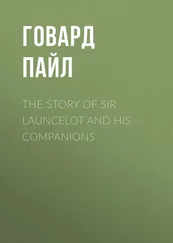Jessie Weston - The Legend of Sir Lancelot du Lac
Здесь есть возможность читать онлайн «Jessie Weston - The Legend of Sir Lancelot du Lac» — ознакомительный отрывок электронной книги совершенно бесплатно, а после прочтения отрывка купить полную версию. В некоторых случаях можно слушать аудио, скачать через торрент в формате fb2 и присутствует краткое содержание. Жанр: foreign_prose, foreign_antique, на английском языке. Описание произведения, (предисловие) а так же отзывы посетителей доступны на портале библиотеки ЛибКат.
- Название:The Legend of Sir Lancelot du Lac
- Автор:
- Жанр:
- Год:неизвестен
- ISBN:нет данных
- Рейтинг книги:5 / 5. Голосов: 1
-
Избранное:Добавить в избранное
- Отзывы:
-
Ваша оценка:
- 100
- 1
- 2
- 3
- 4
- 5
The Legend of Sir Lancelot du Lac: краткое содержание, описание и аннотация
Предлагаем к чтению аннотацию, описание, краткое содержание или предисловие (зависит от того, что написал сам автор книги «The Legend of Sir Lancelot du Lac»). Если вы не нашли необходимую информацию о книге — напишите в комментариях, мы постараемся отыскать её.
The Legend of Sir Lancelot du Lac — читать онлайн ознакомительный отрывок
Ниже представлен текст книги, разбитый по страницам. Система сохранения места последней прочитанной страницы, позволяет с удобством читать онлайн бесплатно книгу «The Legend of Sir Lancelot du Lac», без необходимости каждый раз заново искать на чём Вы остановились. Поставьте закладку, и сможете в любой момент перейти на страницу, на которой закончили чтение.
Интервал:
Закладка:
A messenger now arrives from the Fairy of the Lake, revealing Lanzelet's name and parentage (his mother, Clarine, was sister to Arthur). The object of her theft of the child is now accomplished: she desired to secure a champion who would free her son Mâbûz from his too powerful enemy. Lanzelet decides to seek Gawain, whom he now knows to be his kinsman. On their way they meet a squire who informs them that the King Valerîn (or Falerîn, the spelling varies), has appeared at Arthur's court and laid claim to Guinevere, on the ground that she had been betrothed to him previous to her marriage with Arthur. If Valerîn cannot find a champion to oppose him he will carry off the queen. Lanzelet undertakes the combat, and defeats Valerîn.
(We must note here that Lanzelet's service to the queen is of a preventive character, i.e. he saves her from the possibility of abduction, he does not rescue her after the abduction has taken place.)
Lanzelet then leaves his wife at court, and goes forth to seek the castle of Plurîs, which he had passed on his journey from Meide-land and the adventure of which he desires to test. There he is challenged by one hundred knights, whom he successively overthrows, and weds the queen (Ulrich says quaintly, ' ich enweiz ob erz ungerne tet, wan diu königîn was ein schœne maget , 5530-1). Iblîs remains at Arthur's court, grieving for the disappearance of her husband, during whose absence she successfully withstands the Mantle test, an incident of not infrequent occurrence in Arthurian romance.
Hearing that Lanzelet is a prisoner at Plurîs, Gawain, Karjet (Gaheriet?), Erec, and Tristan go in search of him, and, by means of a ruse, succeed in freeing him. The queen of Plurîs disappears from the story.
On their way to court they learn that, while engaged in hunting the white stag, Guinevere has been carried off by Valerîn, and imprisoned in a magic castle, surrounded by a dense thicket peopled with all kinds of serpents. Tristan, 'der listige Tristan' 20 20 This is entirely in accordance with Tristan's character as represented in the poems. He is in the highest degree rusé and resourceful.
suggests that they should seek the aid of Malduz 21 21 Is it not possible that this Malduz the magician may be the original of Mauduiz li Sages whom Chrétien ranks as eighth of Arthur's knights? Cf. Erec , 1699. Hartmann's version gives Malduiz; Diu Krône , 1379, Malduz der Weise. The identification seems clear.
or Malduc, the magician, the Lord of the Misty Lake (Genibeleten Se), who will enable them to penetrate Valerîn's stronghold. Erec announces that neither he nor Gawain should take part in the expedition as they have respectively slain Malduc's father and brother. Arthur therefore sets forth accompanied by Karjet (Gaheriet), Tristan and Lanzelet (this is the order), and are later joined by Dodine le Sauvage. By the good offices of the enchanter's daughter, to whom Arthur appeals, Malduc consents to aid them on condition that Erec and Gawain are delivered up to him, to which these heroes willingly consent. Malduc then, by means of spells, disperses the serpents guarding Valerîn's castle, slays him and his men, and wakens Guinevere from the magic slumber into which Valerîn has cast her.
I have italicised this passage as extremely important for the criticism of the story. It will be seen that so far from Lanzelet being the means of Guinevere's escape, he plays practically no part in the story, all he does is to accompany the king. The rescuer is Malduc; recourse to him is suggested by Tristan and made possible by the self-sacrifice of Gawain and Erec; but saving in the discussion as to whether Malduc's terms shall or shall not be accepted, Lanzelet's name is not even mentioned. 22 22 I am quite at a loss to account for the mistake into which such authorities as M. Gaston Paris and Professor Foerster have apparently fallen. In M. Paris's study the idea that Lanzelet is the rescuer is perhaps rather implied than stated, but when I wrote the Charrette chapter (viii.) in my Studies on the Legend of Sir Gawain , in which I followed the article in Romania , I was certainly under the impression that the latter was the case. In the introduction to the Karrenritter , p. xliv., Professor Foerster distinctly says that Lanzelet frees the queen. I have read and re-read the text carefully and made my final summary direct from it, and there is no doubt that Lanzelet has nothing to do with the matter. The passage in question is contained in ll. 6975-7445. How too did Professor Foerster come to ignore the real character of Guinevere's imprisonment? Cf. Charrette , lxxi.
Erec and Gawain are cast into prison by Malduc and nearly starved to death, but are rescued by one hundred of Arthur's knights, headed by Lanzelet and aided by a giant, Esealt der lange. They all return to Arthur's court, where great feasts are held.
Iblîs tells her husband of a curious adventure which had befallen one of the knights: how he had met in a forest a terrible dragon which, speaking with a human voice, besought a kiss from the knight; he refused and the dragon flew away lamenting. Lanzelet resolves to test the adventure, rides to the forest, finds the dragon, and gives the desired kiss. The monster bathes in a stream at hand, and becomes a fair maiden, Elidiâ, daughter to the king of Thile; she has been transformed into a dragon for transgressing the rules of Minne , and condemned to remain in that form till kissed by the best knight on earth. She remains at Arthur's court, where she is made judge of all disputed questions relating to Minne .
Here the story of Lanzelet practically ends. He wins back his lands of Genewîs without difficulty, promising to treat his subjects better than his father did. He and Iblîs betake themselves to the heritage of the latter, Beforet, where they receive Arthur and Guinevere with great pomp. The poem concludes by telling us that they have four children, three sons and one daughter, that they live to see their children's children, and die both on the same day.
The poem of Ulrich von Zatzikhoven has scarcely received the attention which, as a factor in the criticism of the legend, it undoubtedly demands. The questions arising out of it are not only interesting, but, as I shall presently show, in one instance at least, of the very highest importance. The questions may be grouped as ( a ) those relating to the structure and sources of the poem itself; ( b ) those which affect its relation to the other Lancelot romances. For the first it is obvious that we are dealing with a poem of very loose construction; the various parts do not harmonise with each other, and no attempt has been made to make them do so. Thus we have no fewer than four love affairs attributed to Lanzelet, and in three out of the four he weds the lady; yet these amours, one of which is subsequent to his marriage with Iblîs, are dropped as of no account. Professor Foerster 23 23 Karrenritter , Introduction, p. xliv.
considers that this looseness of construction points to a late date, and that the source of the Lanzelet was a biographical romance of the weakest order. According to Professor Foerster the clearer the composition, the better knit the incidents, the older the romance.
Now it seems to me that there are two orders of ill-constructed romances, and that we shall do well to differentiate between them. In one case we have a number of incidents of secondary character, obviously borrowed or imitated from those occurring elsewhere, strung together more or less cleverly on the thread of a hero's individuality. The incidents are all to be found in other romances, and as a rule none of them have any suggestion of Celtic or mythic origin. The literary style is superior to the matter. Such romances are e.g. Rigomer , Torec , Le Chevalier à la Manche . A very favourable example is Méraugis de Portlesguez . These are all certainly late romances.
Читать дальшеИнтервал:
Закладка:
Похожие книги на «The Legend of Sir Lancelot du Lac»
Представляем Вашему вниманию похожие книги на «The Legend of Sir Lancelot du Lac» списком для выбора. Мы отобрали схожую по названию и смыслу литературу в надежде предоставить читателям больше вариантов отыскать новые, интересные, ещё непрочитанные произведения.
Обсуждение, отзывы о книге «The Legend of Sir Lancelot du Lac» и просто собственные мнения читателей. Оставьте ваши комментарии, напишите, что Вы думаете о произведении, его смысле или главных героях. Укажите что конкретно понравилось, а что нет, и почему Вы так считаете.












